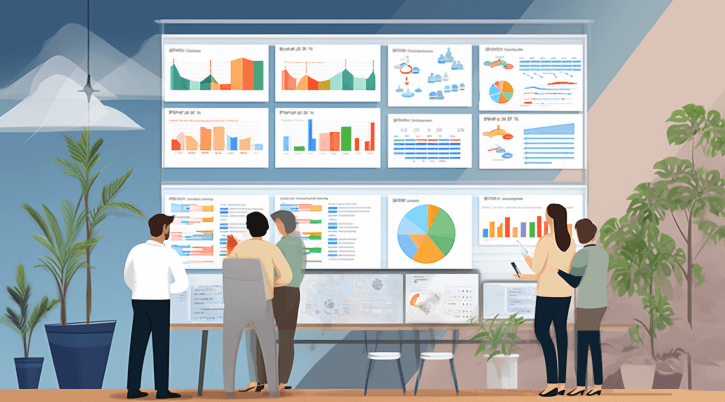The Importance of B2B Lead Generation
In the world of business-to-business (B2B) sales, lead generation plays a crucial role in driving success. By understanding the fundamentals of B2B lead generation and recognizing its significance, businesses can revolutionize their sales strategies and achieve their growth objectives.
Understanding B2B Lead Generation
B2B lead generation refers to the process of identifying and attracting potential customers or leads who have the potential to become paying clients. It involves various tactics and strategies aimed at capturing the interest of individuals or organizations that may be interested in the products or services offered.
Lead generation typically starts with prospecting, where businesses actively search for potential leads through methods such as market research, networking, and referrals. Once leads are identified, businesses engage in lead nurturing activities to build relationships, provide valuable information, and guide leads through the sales funnel.
Why Lead Generation is Crucial for Business Success
Lead generation serves as the foundation of a successful sales pipeline. Without a consistent flow of qualified leads, businesses may struggle to generate revenue and grow their customer base. Here are key reasons why lead generation is crucial for business success:
- Increased Sales Opportunities: Lead generation opens doors to a wider pool of potential customers, providing more opportunities to convert leads into paying clients. By identifying and engaging with leads early in the buying process, businesses can nurture relationships and position themselves as trusted partners.
- Targeted Approach: Through lead generation efforts, businesses can narrow down their focus to target specific industries, demographics, or customer profiles that align with their ideal customer profile (ICP). This targeted approach allows for more efficient use of resources and increases the likelihood of converting leads into customers.
- Business Growth: A consistent influx of qualified leads fuels business growth. By attracting and converting leads, businesses can expand their customer base, increase market share, and drive revenue growth. Lead generation is a vital component of any growth strategy.
- Competitive Edge: In today’s competitive business landscape, effective lead generation strategies provide a competitive edge. By implementing innovative tactics, leveraging technology, and staying ahead of industry trends, businesses can stand out from the competition and capture the attention of potential customers.
By understanding the importance of B2B lead generation and its impact on business success, organizations can prioritize lead generation activities and allocate resources effectively. In the following sections, we will explore the key components and strategies involved in building a strong lead generation foundation.
Building a Strong Foundation
Before diving into the world of B2B lead generation, it’s essential to lay a strong foundation for your efforts. This involves defining your ideal customer profile (ICP) and creating targeted buyer personas.
Defining Your Ideal Customer Profile (ICP)
To effectively generate leads, you need to have a clear understanding of who your ideal customers are. Defining your ICP involves identifying the characteristics and attributes of the companies that are most likely to benefit from your product or service. Consider factors such as industry, company size, location, and specific pain points that your offering can address.
By defining your ICP, you can narrow down your target audience and focus your lead generation efforts on the companies that have the highest potential for conversion. This allows you to tailor your messaging and approach to resonate specifically with your ideal customers, increasing the likelihood of success.
Creating Targeted Buyer Personas
Once you have a clear understanding of your ICP, the next step is to create targeted buyer personas. Buyer personas are fictional representations of your ideal customers. They are based on real data and insights gathered from your existing customer base and market research.
A well-developed buyer persona includes demographic information, job titles, pain points, goals, and motivations of your target customers. It helps you understand their needs, preferences, and challenges, allowing you to tailor your messaging and content to resonate with them on a deeper level. This helps in crafting more effective cold emails and increasing the chances of engagement and conversion.
By creating detailed buyer personas, you can better understand the needs and motivations of your target customers, enabling you to develop more compelling messaging and strategies to attract and engage them.
Understanding your ICP and creating targeted buyer personas serve as the foundation for successful B2B lead generation. These foundational elements allow you to focus your efforts on the right audience and tailor your approach to meet their specific needs. By aligning your messaging and strategies with your ideal customers, you can increase the effectiveness of your lead generation efforts and drive meaningful results.
Remember, lead generation is an ongoing process that requires continuous optimization and adaptation. Stay tuned for the subsequent sections where we will explore effective email outreach strategies and how to leverage technology and automation to enhance your B2B lead generation efforts.
Crafting Compelling Cold Emails
In the realm of B2B lead generation, crafting compelling cold emails is an essential skill for reaching potential prospects. A well-crafted email can pique the recipient’s interest and entice them to learn more about your product or service. In this section, we will explore three key elements of a successful cold email: attention-grabbing subject lines, personalized email content, and clear call-to-action.
Writing an Attention-Grabbing Subject Line
The subject line of your cold email is the first impression you make on your recipient. It should be concise, compelling, and tailored to catch their attention amidst a crowded inbox. A captivating subject line increases the chances of your email being opened and read.
Consider using personalized elements in your subject line, such as the recipient’s name or their company’s name. This adds a touch of personalization and shows that the email is not just a generic mass communication. Additionally, using action-oriented or curiosity-inducing language can create a sense of urgency or intrigue, making the recipient more likely to click on your email. For a comprehensive list of subject line examples, check out our article on cold email subject lines.
Personalizing Your Email Content
Once you’ve captured the recipient’s attention with a compelling subject line, it’s crucial to maintain that engagement throughout the body of your email. Personalization is key in making your cold email feel relevant and tailored to the recipient’s needs.
Start by addressing the recipient by their name and mention something specific about their company or industry to demonstrate that you’ve done your research. This helps to establish a connection and shows that you understand their unique challenges or pain points. Consider referring to relevant articles or blog posts they have published, showcasing your knowledge and expertise. Personalization adds a human touch to your email and increases the chances of a positive response.
Including a Clear Call-to-Action
A clear call-to-action (CTA) is essential in guiding the recipient towards the desired action. Make sure your CTA is concise, specific, and aligned with your overall objective. Whether you want the recipient to schedule a call, download a resource, or visit your website, clearly communicate the next steps they should take.
To make your CTA more compelling, consider adding a sense of urgency or offering an incentive. Limited-time offers or exclusive access to valuable content can motivate the recipient to take immediate action. Additionally, including a direct link or button that leads to the desired destination simplifies the process and increases the likelihood of conversion.
By focusing on attention-grabbing subject lines, personalized email content, and clear call-to-action, you can optimize your cold emails for successful B2B lead generation. Remember to continuously test and refine your email strategies, leveraging tools and analytics to measure your success. For more insights on optimizing your lead generation efforts, explore our articles on lead generation best practices and lead generation tips.
Effective Email Outreach Strategies
To successfully generate leads through email outreach, it’s important to implement effective strategies that maximize engagement and responses. In this section, we will explore three key strategies: building a quality email list, A/B testing and optimizing email campaigns, and following up and nurturing leads.
Building a Quality Email List
The foundation of any successful email outreach campaign is a high-quality email list. A well-curated list ensures that your emails are reaching the right audience, increasing the chances of generating valuable leads. Here are some steps to build a quality email list:
- Identify your target audience: Define your ideal customer profile (ICP) and create targeted buyer personas to understand who you should be targeting. This will help you identify the relevant individuals or companies to include in your email list.
- Utilize lead generation tactics: Implement lead generation techniques such as offering valuable content, hosting webinars, or running social media campaigns to capture email addresses from potential leads.
- Leverage lead generation tools: Utilize lead generation tools or services to streamline the process of collecting and managing email addresses. These tools can help you automate lead capture, track engagement, and segment your email list for personalized outreach.
Remember, building a quality email list is an ongoing process. Continuously update and refine your list to ensure it remains relevant and effective.
A/B Testing and Optimizing Email Campaigns
To maximize the effectiveness of your email campaigns, it’s essential to conduct A/B testing and optimize your approach. A/B testing involves sending different versions of your emails to a subset of your audience and analyzing the results to determine the most effective elements. Here are some aspects to consider when optimizing your email campaigns:
- Subject lines: Experiment with different subject lines to find the ones that grab the recipient’s attention and entice them to open the email. Check out our article on cold email subject lines for inspiration.
- Email content: Personalize your email content to make it relevant and engaging. Consider including personalized snippets such as the recipient’s name or company. Use concise and compelling language to clearly communicate the value proposition of your offering.
- Call-to-action (CTA): Use a clear and actionable CTA that directs the recipient to take the desired action, such as visiting your website or scheduling a call. Test different CTA placements and language to identify what resonates best with your audience.
- Timing and frequency: Experiment with different send times and frequencies to determine when your emails receive the highest engagement. Consider factors such as time zones and the nature of your target audience’s work schedule.
By conducting A/B tests and optimizing your email campaigns based on the results, you can continuously improve your email outreach and increase the likelihood of generating quality leads.
Following up and Nurturing Leads
Following up with your leads is crucial for building and maintaining relationships. Many leads may not respond to your initial email, but a well-crafted follow-up can prompt engagement. Here are some tips for effective follow-ups:
- Personalization: Refer to previous communications or specific details to show that you value the recipient’s time and individual needs. Personalization can significantly increase the chances of receiving a response.
- Persistence without being pushy: Craft follow-up emails that are polite and respectful, reminding the recipient of your previous message and reiterating the value you can provide. Consider using cold email follow-up templates to streamline the process.
- Nurturing sequences: Develop a sequence of follow-up emails that gradually build rapport and provide additional value to the recipient. This can include sharing relevant content, case studies, or success stories.
Remember to track and analyze the engagement and response rates of your follow-up emails. This data can inform future strategies and help you identify the most effective approaches to nurturing your leads.
By implementing these effective email outreach strategies, you can optimize your lead generation efforts and increase the chances of converting prospects into valuable customers.
Leveraging Technology and Automation
In the world of B2B lead generation, technology and automation play a crucial role in streamlining processes and maximizing efficiency. By utilizing email marketing tools, implementing CRM systems for lead management, and analyzing data to measure success, businesses can revolutionize their sales efforts.
Using Email Marketing Tools
Email marketing tools provide a range of features and functionalities to enhance B2B lead generation campaigns. These tools enable businesses to efficiently manage their email outreach, track engagement metrics, and automate various aspects of the process.
Key benefits of using email marketing tools include:
- Automated Campaigns: Easily set up automated email sequences to nurture leads and maintain consistent communication.
- Personalization: Tailor emails with merge tags and dynamic content to create a personalized experience for each recipient.
- Analytics and Reporting: Gain insights into email open rates, click-through rates, and conversions to measure the effectiveness of your campaigns.
- Email Templates: Access pre-designed email templates or create your own, saving time and ensuring a professional appearance.
- List Segmentation: Segment your email list based on various criteria to send targeted messages to specific groups.
To further enhance your cold email outreach, you can explore cold email templates and experiment with different cold email subject lines to improve open rates and response rates.
Implementing CRM Systems for Lead Management
Customer Relationship Management (CRM) systems are essential tools for managing and organizing leads throughout the sales process. These systems allow businesses to centralize lead data, track interactions, and streamline communication between sales teams and prospects.
Key benefits of implementing CRM systems for lead management include:
- Lead Tracking: Store and track lead information, including contact details, communication history, and lead status.
- Sales Pipeline Management: Visualize and manage leads as they progress through the sales funnel, ensuring timely follow-ups and conversions.
- Automated Lead Assignment: Assign leads to specific sales representatives based on predefined criteria, ensuring efficient lead distribution.
- Data Analysis: Analyze lead data to identify patterns, track performance, and make data-driven decisions to optimize sales strategies.
By implementing CRM systems, businesses can effectively manage their leads, improve collaboration among sales teams, and enhance overall sales productivity.
Analyzing Data and Measuring Success
Data analysis is a critical component of B2B lead generation. By analyzing data collected from email campaigns and CRM systems, businesses can gain valuable insights into the effectiveness of their strategies and identify areas for improvement.
Key metrics to analyze for measuring success include:
- Open Rates: Measure the percentage of recipients who opened your email, indicating how engaging your subject lines and email content are.
- Click-Through Rates (CTRs): Determine the percentage of recipients who clicked on links within your email, highlighting the effectiveness of your call-to-action and content.
- Conversion Rates: Track the percentage of leads who took the desired action, such as filling out a form or scheduling a demo, providing insights into the overall effectiveness of your lead generation efforts.
- ROI: Calculate the return on investment for your lead generation campaigns by comparing the revenue generated from converted leads against the cost of your campaigns.
Regularly analyzing these metrics allows businesses to optimize their strategies, refine their messaging, and continuously improve their B2B lead generation efforts.
By leveraging technology and automation through email marketing tools, CRM systems, and data analysis, businesses can enhance their B2B lead generation strategies. These tools enable efficient outreach, effective lead management, and data-driven decision-making, leading to improved results and increased business success.
Best Practices for B2B Lead Generation
To excel in B2B lead generation, it’s crucial to follow best practices that ensure your efforts yield optimal results. This section will explore three important practices: maintaining GDPR and CAN-SPAM compliance, honing your sales pitch and value proposition, and continuously learning and adapting strategies.
Maintaining GDPR and CAN-SPAM Compliance
In the world of B2B lead generation, it’s vital to prioritize compliance with data protection regulations. The General Data Protection Regulation (GDPR) and the Controlling the Assault of Non-Solicited Pornography And Marketing (CAN-SPAM) Act are two key regulations that govern email marketing practices.
GDPR, applicable to businesses operating within the European Union, mandates that organizations obtain explicit consent from individuals before sending them marketing emails. It also ensures individuals have the right to access and control their personal data. On the other hand, CAN-SPAM regulates commercial emails in the United States and requires that businesses provide recipients with a clear option to unsubscribe from future emails.
By adhering to these regulations, you not only maintain legal compliance but also build trust with your prospects. For more information on best practices related to email marketing compliance, check out our article on GDPR and CAN-SPAM compliance.
Honing Your Sales Pitch and Value Proposition
Crafting a compelling sales pitch and value proposition is essential for effective B2B lead generation. Your pitch should clearly communicate the unique value your product or service offers to potential customers. It should address their pain points, showcase how your offering solves their problems, and highlight the benefits they can expect.
To create an impactful sales pitch, conduct thorough research on your target audience and understand their specific needs and challenges. Tailor your messaging accordingly to resonate with their pain points. Remember to focus on the value and benefits your solution brings, rather than solely emphasizing its features.
Regularly evaluating and refining your sales pitch based on feedback and market trends is crucial. It allows you to stay relevant, address changing customer needs, and differentiate yourself from competitors. For more insights on crafting an effective sales pitch and value proposition, refer to our article on sales pitch and value proposition.
Continuously Learning and Adapting Strategies
The world of B2B lead generation is ever-evolving, driven by changing customer behaviors, market trends, and emerging technologies. To stay ahead, it’s important to adopt a mindset of continuous learning and adaptability.
Regularly analyze your lead generation efforts to identify areas of improvement. Track key metrics such as conversion rates, open rates, and response rates to gauge the effectiveness of your strategies. This data-driven approach helps you identify what’s working well and what needs adjustment.
Stay updated on industry trends, attend conferences, and network with professionals to gain insights into new lead generation techniques and strategies. Embrace new technologies and automation tools that can streamline your processes and enhance your efficiency. By continuously learning and adapting, you can optimize your lead generation efforts and stay competitive in the B2B landscape.
By maintaining GDPR and CAN-SPAM compliance, honing your sales pitch and value proposition, and continuously learning and adapting your strategies, you can revolutionize your B2B lead generation efforts and drive sustainable business growth. Stay informed, remain customer-centric, and be willing to evolve in order to achieve success in this dynamic field.



